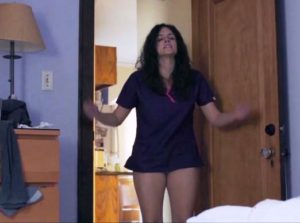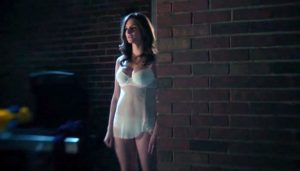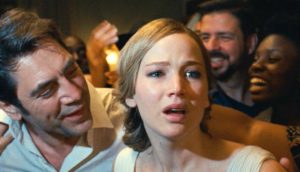
Cold War is a new romantic comedy with Madeline Walter about a young couple whose relationship is tested — to put it mildly — when a crippling flu bug confines them to close quarters for days on end. We talked to Walter about the movie. We also let Rip van Dinkle ask her a question. Just one question.
**
GE: Your movie reminded me of Hollywood “bickering couple” classics like War of the Roses, His Girl Friday, etc. Were you familiar with those movies, and was Cold War a conscious attempt to carry on that tradition?
MW: I believe it was! I have a woefully limited knowledge of classic films, but [co-directors] Stirling and Wilder are both film buffs, and I know they were inspired by many of the classics. When I was preparing for the shoot, Wilder referred me to some movies that had inspired him, and the one that I actually drew from the most was the original Odd Couple with Jack Lemmon and Walter Matthau. I think that movie is brilliant, and just really beautifully captures the dynamic of two people with intensely different lifestyles and hangups trying to live together (and making it work because they ultimately deeply care about each other). Also, fun fact — in the scene in the movie where Jon notices that Maggie’s labeled their duplicate DVDs, the DVD that he pulls out is His Girl Friday.
**
GE: Which comic actresses inspire you?
MW: A bunch! Kathryn Hahn, Issa Rae, Sharon Horgan come to mind — they all make such funny choices that really come out of such grounded, surprising emotional places. I’m also an improviser, and I learned pretty much everything I know about performing at the UCB theatre, so a lot of the women I perform with are really inspiring to me. So much of the time I’m just stealing what they do and trying to make it my own.
**
GE: The movie was basically a two-person show (I can see it as a stage play), and you and Michael Blaiklock are in most scenes together. Is that a good working situation for you, or do you prefer a larger cast?
MW: This was my first feature film, so I really loved working with such a small cast. It really allowed me to focus on my character’s relationship to one person, and gave me the time to explore and examine that relationship and make clear choices about its evolution. Also, I have to say, doing a two-person movie with Michael specifically was awesome- everything he did was so present and surprising, and he made it really fun. I highly recommend doing a two-person movie with him if the opportunity comes up!
**
GE: I’d say one lesson of Cold War is that yes, you can spend too much time with a significant other. Assuming you were/are in a relationship with another person, what would you say is the ideal amount of time to spend together?
MW: I think it’s nice to spend enough time apart so you both have interesting answers to “how was your day?”
**
GE: Between you and Michael, there was quite a bit of puking in the movie. Was that method acting, perhaps residual memories from college days?
MW: I wish … but unfortunately my wildest college experience was a time I stayed up all night organizing a filing cabinet. I am very proud of our puking sounds though — the most fun was doing ADR. Something feels so wrong (yet so right) about standing in a super polished recording studio and gagging into a state-of-the-art microphone.
**
Editor’s note: Rip van Dinkle was impressed by a scene in Cold War in which nurse Madeline shares screen time with a nude actor and his noodle. We let him ask Madeline one question.

Rip: The scene in which you examine the naked patient was hilarious. I was in “The Smallest Penis in Brooklyn” pageant and I know that it can be like pulling teeth trying to find men who are willing to do something like that. Was that an awkward scene for you to film? Did the actor have any qualms about revealing his shortcomings to the world?
MW: You know, it wasn’t as awkward as I thought it would be, because Kenneth [Yoder], who played the patient, is a total pro. And I really just super appreciated that Wilder and Stirling showed full frontal male nudity in the type of movie where female nudity is usually much more common. They really made an effort to flip rom-com tropes in a lot of ways, and that’s what made this movie so exciting to me.
. 


**
Editor’s note: In the interests of equal time — lest anyone think that the patient with the flaccid penis represents the only skin on display in Cold War — here are some revealing screen shots of Madeline in the film:




(Click on pictures for a larger, better view.)
© 2010-2024 grouchyeditor.com (text only)

























